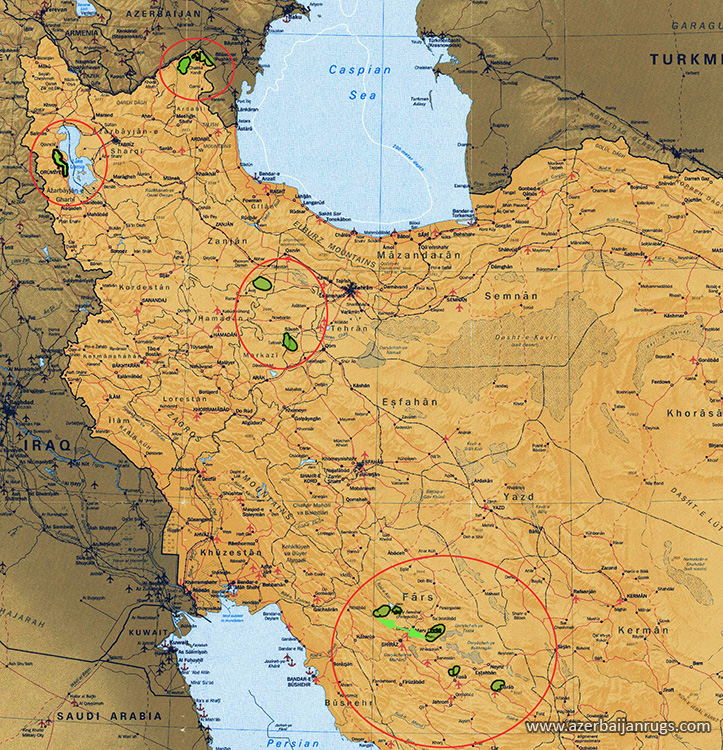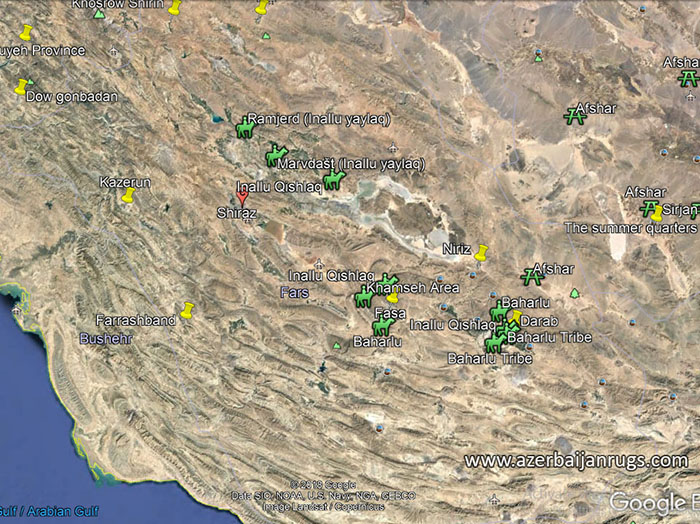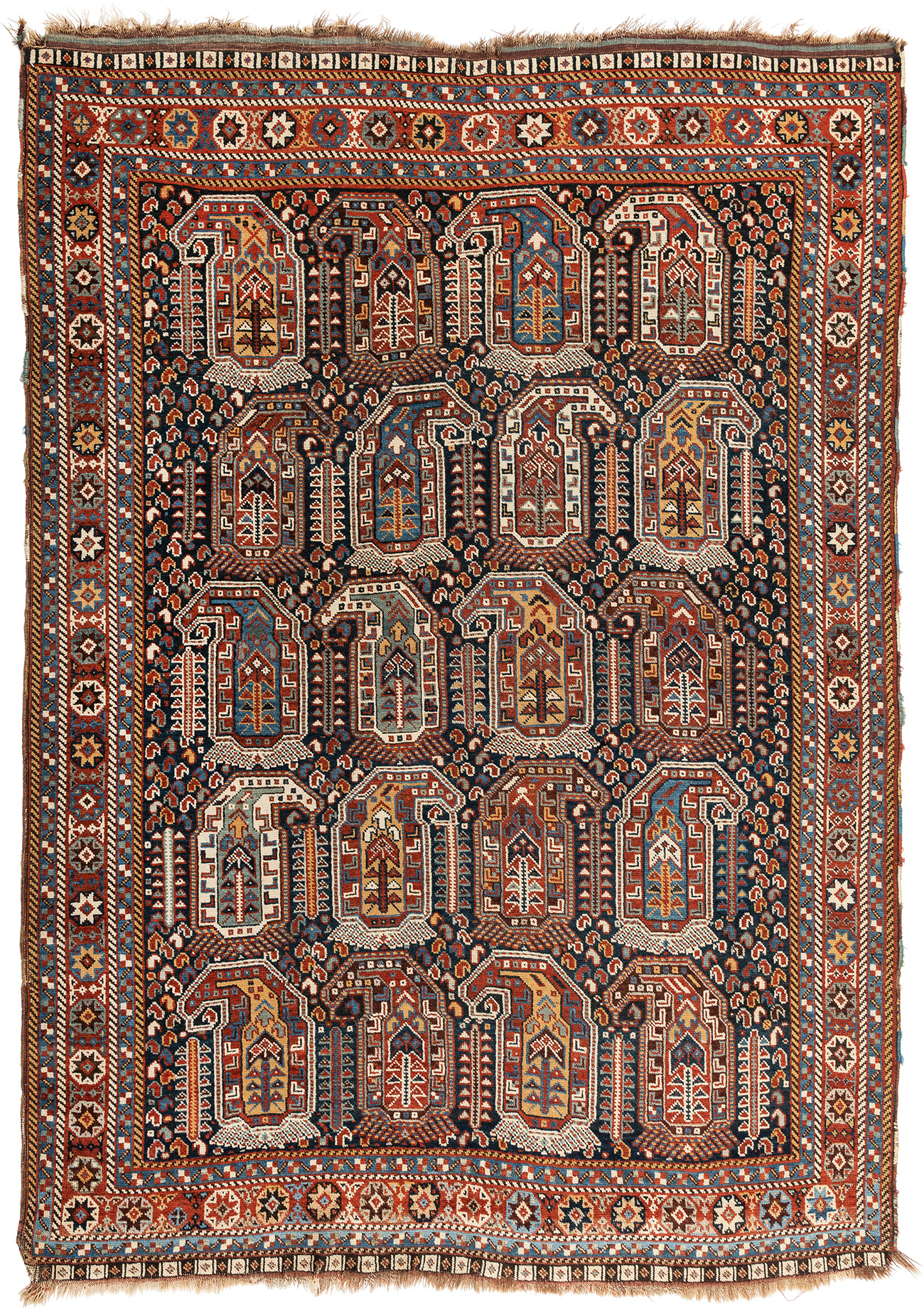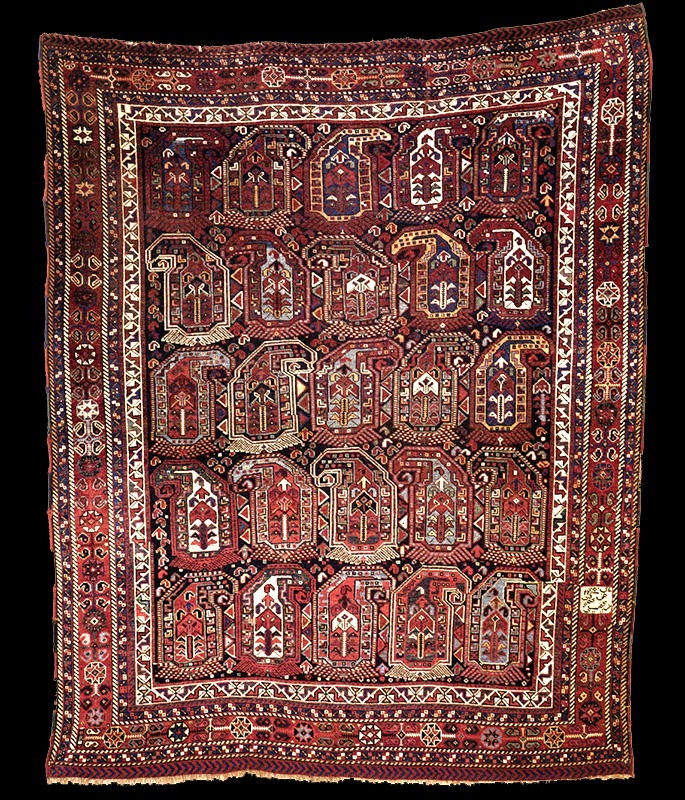Antique Khamseh rug,
probably Inallu (Aynallu, Inalu, Inanlu) tribe
Code:
KHI28
Age: c 1890
Size: 143x186cm
Size (ft): 4'8"x6'1"
Structure: wool pile, brown and ivory wool warps
twisted and
dark brownish red wool wefts.
Knots: Gördes (Turkish, symmetrical)
Condition: Good pile. Original selvedge. Minor damages to
the lower and upper kilim end due to age. Overall well preserved.
Notes: Acquired from a private collection in Germany.
The rug was woven in the late 19th century in the south east of Shiraz,
probably by Inallu tribe of the Khamseh confederation. Khamseh was
consisted of mainly Turkic tribes (Inallu, Baharlu and Nafar) of Shiraz
(Fars) province, and partly Arabs of mixed origin. Basseri, which is also
one of the Khamseh tribes are descended from Arabic, Persian and Turkish.
Inallu (Aynallu, Ainalu, Inalu, Inanlu) is a tribe of Oghuz Turkic
origin who settled in Azerbaijan and Iran in Seljuk Period. In Safavid
Period, they were a part of powerful Afshar tribe. Inallu tribe backed the
Safavids, in the beginning as Qizilbash/Qyzylbash and later as a part of
Shahsevan Conferederation. (R. Tapper, “Shahsevan,” pp. 339-40).
Today Inallu tribe inhabits Azerbaijan, Central Iran and Fars provinces.
According to Minorsky, the name of this tribe was derived from the Turkic
title "inal", or "yinal". He suggested that the original Inallu might have
constituted the family and retinue of Ibrahim Inal, the half-brother of
the Seljuq ruler Toghrul. When the tribe was later incorporated into the
Shahsevan tribal confederacy, its name was changed to Imanlu, meaning
“Those of the faith,” and Inanlu, from the Turkish verb "inan" - “to
believe”
First group of Inallu forms one of the chief clans of the
Afshar tribe of Urmia (Nikitine, “Les Afshars d’Urumiyeh,” pp. 105-08).
Shah ʿAbbas I gave was the Urmia region to Kalb-e ʿAli Khan Imanlu as a
fief and he was followed by a series of other Inallu governors (Nikitine,
op. cit., pp. 73, 105, 106).
The second goup is a part of the
Shahsevan tribe of northeastern Azerbaijan (Oberling, The Turkic Peoples,
pp. 6, 13, 26).
A third group of Inallu belongs to the Shahsevans
of Central Iran. According to H. Field, these Inallus were forced to move
into the area from northeastern Azerbaijan by Agha Muhammad Khan Qajar
(r.1779-97) (Contributions, p. 171). Field estimated their number at from
5,000 to 6,000 families (ibid.) and Kayhan at 10,000 families (Joghrafia
II, p. 112). Their winter quarters are near Sava; their summer quarters
are near Qazvin. Many have settled down in villages in the bakshes of
Zarand and Abyak (Razmara, Farhang I, pp. 72, 194, 234).
A fourth
group of Inallu inhabits southeastern Fars Province. These Inallus/Inalu
almost certainly came to Fars by way of central Iran. When it was still
nomadic, the Inallu tribe of Fars had its winter quarters in the boluks of
Kafr, Darab, and Fasa, and its summer quarters in the boluks of Ramjerd
and Marvdasht (cf. Fasaʾi, p. 309). Until 1860, Inallus were living
together with Qashqai in this area. In 1861-62, when the Khamsa tribal
confederacy was formed to counterbalance the growing influence of the
Qashqaʾi tribal confederacy, the Inallu tribe was one of the five tribes
selected for that purpose. It thereby fell under the domination of the
wealthy Qawam family of Shiraz, which had been placed in charge of the new
confederacy. The Inallu of Fars were accomplished raiders and banditti.
But in 1876 they were severely punished by Moʿtamed-al-dawla Farhad Mirza,
the governor general of Fars, and were forced to become sedentary (Fasaʾi,
pp. 309-10; G. Demorgny, “Les réformes,” p. 102). Before World War I,
Demorgny estimated their number at 5,000 families (op. cit., p. 102), and
A. T. Wilson at 4,000 families (Report, p. 48). Today, these Inallu people
inhabit several villages on the open country east of Fasa (Razmara,
Farhang VII, pp. 59, 113, 159, 171).

Inallu tribe living areas in Iran

Inallu living areas in Shiraz/Fars province |
Bibliography:
L. W. Adamec, ed., Historical Gazetteer of
Iran I: Tehran and Northwestern Iran, Graz, 1976, pp. 589-91.
G.
Demorgny, “Les réformes administratives en Perse: Les tribus du Fars,”
Revue du monde musulman 22, 1913, pp. 85-150.
H. Field, Contributions
to the Anthropology of Iran, Chicago, 1939.
L. S. Fortescue, Military
Report on Tehran and Adjacent Provinces of North-Western Persia, Calcutta,
1922.
M. S. Ivanov, Plemena Farsa, Moscow, 1961.
J. M. Jouannin’s
list of the tribes of Iran, in A. Dupré, Voyage en Perse, Paris, 1819, II,
pp. 456-68.
T. Kowalski, “Sir Aurel Stein’s Sprachaufzeichnungen im
Äḭnallu-Dialekt aus Südpersien,” Polska Akademia Umietjetności 29, 1937.
B. V. Miller, “Kochevye plemena Farsistana,” Vostochnyĭ Sbornik 2, 1916,
pp. 200-23.
V. Minorsky, “Äḭnallu/Inallu,” Rocznik Orientalistyczny 17,
1953, pp. 1-11.
B. Nikitine, “Les Afshars d’Urumiyeh,” JA,
January-March, 1929, pp. 67-123.
P. Oberling, The Turkic Peoples of
Azerbayjan, American Council of Learned Societies, 1964. R. Tapper,
“Shahsevan in Safavid Persia,” BSOAS 37/2, 1974, pp. 321-54.
A. G.
Tumansky, “Ot Kaspiĭskogo morya k Hormuzdskomu prolivu i obratno,” Sbornik
Materialov po Azii 65, 1986, pp. 76-81.
A. T. Wilson, Report on Fars,
Simla, 1916.
Design: Five rows of four
large Boteh motifs on each row, alternately aligned to the right and left,
form a pattern repeat on the dark blue background. Remarkably beautiful
tones of yellow, blue, maroon and green. The large boteh motives are accompanied
with tiny botehs and small stylized trees. Elegant red-ground main border
with a Babylonian star motif.
|




